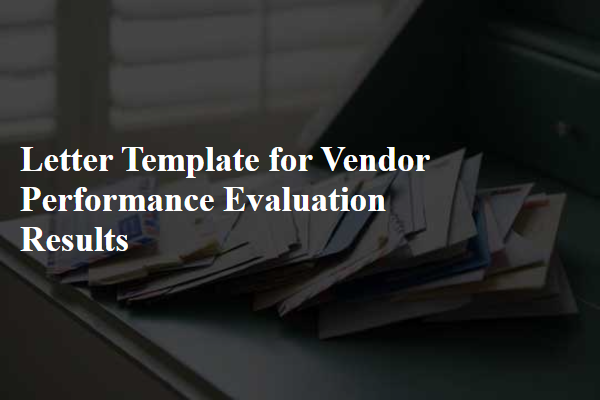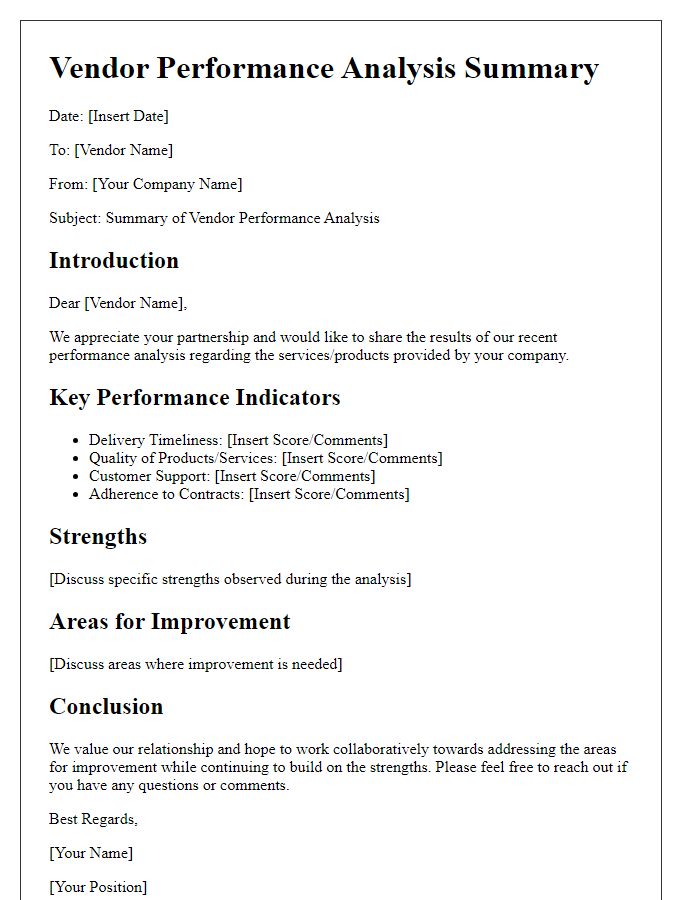Are you looking to assess your vendor's performance effectively? Conducting a vendor performance evaluation is essential for maintaining strong business relationships and ensuring quality service. By providing clear feedback and insights, you can help your vendors improve and align their offerings with your company's needs. Join us as we explore a comprehensive letter template that will guide you through sharing evaluation results with your vendors.

Vendor Information (Name, contact details)
Vendor performance evaluations are essential for assessing the quality and reliability of suppliers like XYZ Corp, located at 123 Business Lane, Cityville, with contact number (555) 123-4567. This yearly assessment includes criteria such as delivery timelines, product quality metrics, and customer service responsiveness. Data from the last quarter indicates a delivery punctuality rate of 95%, exceeding the industry standard of 90%, while product defect rates stood at a commendable 2%, significantly lower than the average benchmark of 5%. Enhanced communication from the vendor's support team, operational since June 2022, has contributed positively to resolving inquiries within an average of 24 hours, fostering a stronger partnership.
Evaluation Summary (Performance overview, key performance indicators)
The vendor performance evaluation summary provides critical insights into the effectiveness and efficiency of service delivery. Key performance indicators (KPIs), such as on-time delivery rates that ideally exceed 95%, quality assurance metrics reflecting less than 2% defect rates, and customer satisfaction scores averaging above 4.5 on a 5-point scale, offer quantitative benchmarks for assessment. This overview also includes qualitative analyses of responsiveness and communication effectiveness, often gauged through response times during project coordination or issue resolution metrics. Continuous monitoring of these aspects enables organizations to uphold standards within supply chain management and foster meaningful partnerships with vendors across various sectors.
Strengths and Achievements (Areas of high performance, notable successes)
The vendor performance evaluation highlighted significant strengths and achievements from the past year. Notably, the consistent on-time delivery rate stood at 98%, surpassing the industry average of 90% for logistics providers, ensuring that critical project timelines were met without delays. Customer satisfaction feedback indicated a remarkable 4.8 out of 5 rating, reflecting excellent service quality and responsiveness to inquiries. The vendor successfully executed a high-profile contract, resulting in a 25% increase in sales revenue for the partnered product line. Additionally, innovative solutions, such as implementing a new inventory management software, reduced stock discrepancies by 15%, optimizing overall operational efficiency. Overall, the vendor demonstrated exceptional performance across key metrics, contributing positively to business objectives.
Areas for Improvement (Challenges faced, improvement suggestions)
Vendor performance evaluations often reveal critical areas for improvement, highlighting challenges encountered during service delivery and proposing actionable suggestions for enhancement. Common challenges may include inconsistent product quality, as noted in quarterly assessments revealing a 15% defect rate, delayed deliveries impacting inventory management in key regions such as the Northeast, and inadequate communication regarding order status updates. Improvement suggestions could range from implementing stricter quality control measures, utilizing automated tracking systems for real-time updates on order fulfillment, to enhancing staff training programs focused on customer service excellence. Establishing regular feedback loops, such as monthly performance review meetings, can also foster a collaborative approach to address these concerns effectively.
Future Recommendations (Expectations, potential collaboration opportunities)
Future vendor performance evaluations highlight key expectations and collaboration opportunities crucial for enhancing business relationships. Regular assessments can identify areas for improvement, such as timely delivery (targeting less than 48 hours for optimal supply chain efficiency) and product quality (maintaining a defect rate below 2%). Enhancing communication strategies, such as weekly performance updates, can foster transparency and trust. Additionally, exploring joint product development initiatives can leverage both parties' strengths, perhaps focusing on eco-friendly materials that align with growing market demand. Implementing a biannual review process can ensure alignment on strategic goals and foster continuous improvement, ultimately leading to a more robust partnership and shared success in the competitive landscape.













Comments